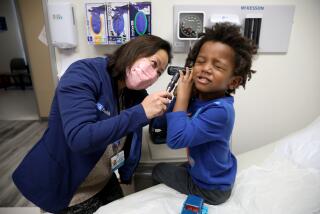1 of 3 in L.A. Lacks Health Coverage, Study Says
- Share via
Nearly a third of non-elderly Los Angeles-area residents lack health insurance, the second-lowest coverage rate among the 85 largest metropolitan areas nationwide, UCLA researchers report today in the largest study of its kind.
The Los Angeles area also has a significantly below-average rate of job-based coverage--a key factor in its poor showing overall, researchers from the UCLA Center for Health Policy Research said. Less than half of residents here are insured through their jobs, compared to an average of 67% among all cities studied.
Nationally, nearly a fifth of non-elderly urban residents have no coverage, with minorities the least likely to be covered. Latinos make up a third of the population of urban areas with high rates of uninsured and just 4% of areas with low rates, according to the study. Elderly people in the United States are covered by the federal Medicare program.
Metropolitan areas with the most serious gaps also tend to have more small employers and low-wage workers, the study found. Los Angeles fits the profile, with many Latinos working in service and retail jobs offering little or no coverage. The Los Angeles area tied with Houston in the second-worst slot; in both cities, 31% of non-elderly residents are uninsured. The worst-off large city in the nation is El Paso, which has a significant Mexican American immigrant population. Its rate is 39%.
Other areas with poor insurance coverage include Tucson, Miami, San Antonio and New York, according to the report, which is based on Census Bureau polls in March 1996 and March 1997.
A substantial portion of the uninsured are children--as many as 1.7 million in California alone. An earlier UCLA study found that nearly 90% of them live in families in which at least one parent is working. Throughout the nation, the growing number of uninsured people presents a dilemma because it results in delayed and more costly treatment.
The UCLA researchers suggest that government needs to step in as job-based coverage falls off. Calling the decline in employer coverage “inevitable,” E. Rick Brown, one of the study’s authors, said the most practical solution is to expand state Medicaid programs--or create alternative programs--to cover more of the working poor.
He illustrates the point by comparing two U.S. cities: Memphis, Tenn., and Fort Lauderdale, Fla. Both have slightly below average rates of work-related insurance coverage. But Tennessee, by obtaining federal permission to expand Medicaid, has boosted overall coverage in Memphis to just above the national average. By contrast, Fort Lauderdale, in a state with a far less generous Medicaid program, is struggling with coverage below average.
Patient advocates say California presents a particularly nettlesome problem because it has a large Latino population that finds the Medi-Cal system difficult to navigate or is reluctant to enroll in the current program--let alone participate in any expansion.
Brown estimated that last year more than 600,000 uninsured children in California were eligible for Medi-Cal but not enrolled. Advocates say many of these children come from families in which parents often are stymied by the bureaucracy, shrink from the stigma of welfare or fear that enrollment of their children will somehow jeopardize their families’ immigration or naturalization status. Some parents believe that the government someday will try to collect the family’s “debt,” although the practice is illegal.
The state has made efforts to expand its coverage of children of the working poor through a government-subsidized insurance program called Healthy Families, serving families too well-off for Medi-Cal but too poor to buy insurance. But that program has also made slow progress in enrollment--causing advocates to criticize its structure and approach.
In this context, many consumer advocates say California needs not just to expand coverage to adults through Medi-Cal and Healthy Families, but to vastly improve the coordination and streamline the operation of both programs.
“For the Latino population, the biggest challenge is restoring the guarantee of confidentiality, so people will come back to Medi-Cal” instead of steering clear for fear of being reported to the Immigration and Naturalization Service, said Lucy Quacinella, staff attorney for the Western Center on Law and Poverty.
Advocates also say the stigma of Medi-Cal must be diminished. “There are a lot of Latinos that would do without than go receive what they see as welfare,” said Patricia Barrera, director of policy for the Latino Coalition for a Healthy California.
(BEGIN TEXT OF INFOBOX / INFOGRAPHIC)
The Uninsured
Los Angeles ranks significantly higher than the national average in percentage of the population under 65 that lacks health insurance. Only El Paso ranks higher among major cities.
El Paso: 39%
Los Angeles: 31%
Houston: 31%
Tucson: 29%
Miami: 28%
San Antonio: 27%
New York City: 25%
Jersey City: 25%
San Diego: 24%
Las Vegas: 23%
Dallas: 23%
Fort Lauderdale: 23%
National average: 18%
*
Source: UCLA Center for Health Policy
More to Read
Sign up for Essential California
The most important California stories and recommendations in your inbox every morning.
You may occasionally receive promotional content from the Los Angeles Times.













